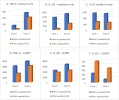Favorable responses to upadacitinib, a JAK1 inhibitor, in long COVID patients with predominant neuropsychiatric symptoms: case reports in 2 autistic patients and one typically developing patient
Harumi Jyonouchi, Jeffery Kornitzer, Lee Geng
[Line breaks added]
Abstract
The long-term impact of coronavirus disease 2019 (COVID-19) has become evident over the past 3–4 years, with the recognition of post-COVID long-term sequelae, often referred to as long COVID. Neuropsychiatric symptoms are one of the hallmarks of long COVID. In severe cases, it can even present features of encephalopathy.
Since some of the neuropsychiatric symptoms associated with long COVID overlap symptoms found in neuropsychiatric disorders, it has been difficult to sort out the effects of long COVID in such subjects. This is especially true in patients diagnosed with autism spectrum disorders (ASD), given their difficult behavioral symptoms and other co-morbid conditions.
COVID-19 is thought to affect the onset or progress of encephalopathy symptoms by activation of the immune system through the type 1 interferon (IFN) signaling pathway. In that case, treatment would require an immunomodulating agent that targets such pathways. However, such measures may not be applied to ASD subjects, in whom long COVID may not even be considered as the cause of their symptoms.
In this study, we present the beneficial effects of upadacitinib, a JAK (janus kinase) 1 inhibitor, that blocks downstream signaling of type 1 IFNs, on 3 patients, 2 with ASD and one without ASD. In these patients, long COVID was thought to have triggered or aggravated encephalopathy-like symptoms.
The beneficial effects of upadacitinib were not only noted by an improvement of their behavioral symptoms but also shown by an improvement of monocyte cytokine profiles (less activated state); peripheral blood monocytes were used as surrogates of microglial cells.
These three cases presented highlight a possible use of JAK inhibitors for treating long COVID-associated neuropsychiatric symptoms in both ASD and non-ASD subjects. The presented cases highlight the inherent difficulty of diagnosing long COVID in ASD cases.
Web | PDF | BMC Neurology | Open Access
Harumi Jyonouchi, Jeffery Kornitzer, Lee Geng
[Line breaks added]
Abstract
The long-term impact of coronavirus disease 2019 (COVID-19) has become evident over the past 3–4 years, with the recognition of post-COVID long-term sequelae, often referred to as long COVID. Neuropsychiatric symptoms are one of the hallmarks of long COVID. In severe cases, it can even present features of encephalopathy.
Since some of the neuropsychiatric symptoms associated with long COVID overlap symptoms found in neuropsychiatric disorders, it has been difficult to sort out the effects of long COVID in such subjects. This is especially true in patients diagnosed with autism spectrum disorders (ASD), given their difficult behavioral symptoms and other co-morbid conditions.
COVID-19 is thought to affect the onset or progress of encephalopathy symptoms by activation of the immune system through the type 1 interferon (IFN) signaling pathway. In that case, treatment would require an immunomodulating agent that targets such pathways. However, such measures may not be applied to ASD subjects, in whom long COVID may not even be considered as the cause of their symptoms.
In this study, we present the beneficial effects of upadacitinib, a JAK (janus kinase) 1 inhibitor, that blocks downstream signaling of type 1 IFNs, on 3 patients, 2 with ASD and one without ASD. In these patients, long COVID was thought to have triggered or aggravated encephalopathy-like symptoms.
The beneficial effects of upadacitinib were not only noted by an improvement of their behavioral symptoms but also shown by an improvement of monocyte cytokine profiles (less activated state); peripheral blood monocytes were used as surrogates of microglial cells.
These three cases presented highlight a possible use of JAK inhibitors for treating long COVID-associated neuropsychiatric symptoms in both ASD and non-ASD subjects. The presented cases highlight the inherent difficulty of diagnosing long COVID in ASD cases.
Web | PDF | BMC Neurology | Open Access

